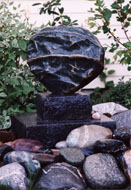Driving to Camp Brotherhood for the first time in July 2001, I looked forward not only to sculpting and meeting sculptors, but also to collecting stones along nearby Pilchuck Creek. I was especially eager to get some of the nephritic jade said to be found there. At daybreak of Camp B’s third day, I drove south on Hwy 9 to check out the stream’s accessibility where the bridge crosses it. No problem. I reconnoitered downstream, collecting two nice cobbles—a green one with intricate surface veining that was some kind of serpentine, and a brown one with an intriguing corrugated texture that (I learned a month later) was a jade striated by some less resistant mineral. I returned early the next morning for a thorough search. More impressed by the first find, I was on the lookout for a larger serpentine. Going upstream for a quarter of a mile, I spotted many of about the same size as my first cobble, a few boulders weighing more than a ton, and a fine two-man stone.

As I drove back to CB for breakfast, I imagined that by offering this serpentine to Wednesday’s benefit auction, I could enlist someone to help collect it, who, like me, had not brought any donations. Tom Small volunteered. Early the next day, equipped with Vic Picou’s hand truck, we sloshed upstream to the stone. While I lashed it onto the dolly, he scouted out a steep but short route from the stream’s bed to a little-used side road. Up we went with Tom pulling from above and me pushing from below. As we toiled, Tom couldn’t resist observing that a rope and pulley simplified non-motorized stone collecting. We laughed, and I silently resolved to incorporate these essentials into my gear. Back to CB’s main lodge with the stone in time for breakfast, I was happy to announce our donation to the following day’s auction.
I secretly hoped that I would manage to be the top bidder for the stone. However, knowing that I have difficulty resisting auction fever, I resolved before the bidding began not to go above $100. Little did I foresee how successful auctioneer Elaine McKay would be at whipping up our interest or how cagey then vice president Ken Barnes would be in a bidding contest. The outcome was that I did acquire the serpentine, but at a price of $180!
That fall I had time to start turning my dearly acquired stone into the centerpiece of a fountain. At CB, I had not only met Rich Hestekind but heard through the grapevine that he was a fountain guru. So I called for advice. We agreed on a time for me to bring the serpentine to his studio near Marenako’s Rock Center to discuss the project. After hearing my plan to orient the predominant surface veins vertically, Rich suggested instead that veins should be horizontal so that they would slow the water’s descent. After considering my notion of using a quarter-ton granite boulder for the fountain’s base, he proposed using a two-tier, diorite plinth for this purpose. I readily recognized the aesthetic and practical advantages of Rich’s ideas.
A month or so later, after I had carved the serpentine’s top basin and leveled its bottom and Marenako’s had pressure-split a diorite riser into 2’x2’ and 1’x1’ blocks for the plinth; I again met Rich at his studio. There, for a price that struck me as eminently fair, he did the requisite coring and provided me with the stainless hardware needed both to link the serpentine to its plinth and to conduct the water upwards. He also outlined the several remaining steps that would need to be taken before I would have a working fountain in my front garden.
Just a few weeks before CB 2002 and thanks to additional advice and pool supplies from Seattle’s Sky Nursery and to help and encouragement from neighbors and family, the fountain was finally up and running. The pleasures of seeing and hearing the water play over the serpentine and its base have been delightful ever since. They have also been a daily reminder of CB and the spirit of cooperation that flourishes there.

